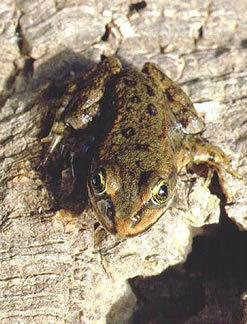

NATURE NOTES

Oregon Spotted Frog (Rana pretiosa), photo by David Blevins
Not Yet Ore-gone
Before there were dikes, ditches and pumphouses, at this time of year the Fraser River would begin to expand across its floodplain. Later, as the waters retreated to the river, the remaining ephemeral ponds would come alive, visited by migrant shorebirds and waterfowl, and filled with breeding clusters of salamanders and choruses of toads and frogs. Among the amphibian songs would have been a modest voice, a peculiar knockin-on-wood call, a sound heard almost nowhere anymore. It was the mating call of the now extremely rare Oregon Spotted Frog, one of the most endangered amphibians in Canada.
The Oregon Spotted Frog is small, five to ten centimetres long, and slightly odd-looking. Rather than sitting upright, like a typical frog, it has a lazy, sprawling posture. Its eyes are directed upward, rather that to the side. These traits are related to its habit it is more aquatic than most species, rarely leaving the water. Once found from northern California to southwestern BC, it is now gone from ninety percent of its historical range. It was recognized as endangered in Canada in 1999, when only a few hundred adult frogs remained.
The main reason for this frogs decline is habitat loss. Among the habitats least useful to human concerns, and most easily converted to something more useful, are shallow, open wetlands. In such places, which warm quickly in the early spring sun, Oregon Spotted Frog females would lay their hundreds of eggs. Eggs are deposited communally - in large clumps in open water only a few centimetres deep. The Lower Mainland has lost 90 percent of its wetlands in last century. The shallow, frog-worthy expanses have been sucked dry by efficient drainage features ditches and canals with water too deep, cold, and fast-moving for this species. The vast proportion of former Oregon Spotted Frog habitat in Canada is now agricultural land, which, making things worse, inevitably sends pesticides and fertilizers into remaining breeding sites. Introduced invasive plants such as reed canary grass and purple loosestrife add further stresses, clogging the shallow edges of ponds where the frogs would otherwise lay their eggs. Randomly but relentlessly, one frog population after another has been lost, leaving only a few, isolated examples.
The Oregon Spotted Frog is now extinct in California, is known from twenty-three sites in Oregon, and only four in Washington. There are three relatively secure populations in BC, one in Aldergrove, one in Agassiz, and one at nearby Seabird Island. It has been recognized that to save the species, these last, best populations must be protected, and a major component of that is the captive rearing of tadpoles to froglet stage. This is being done at the Greater Vancouver Zoo, and, since 2003, at the Mountain View Conservation and Breeding Centre Society in Langley. Mountain View, known largely for its breeding programs for endangered exotic species, animals from Africa, Asia, South America and elsewhere, is carrying on an increasingly intensive larval-rearing program for the frog. In March, eggs or early-stage tadpoles are collected from breeding sites. Under the watchful eye of Carnivore Section Keeper Andrea Gielens, they are counted, and placed in large outdoor tanks that are kept behind protective mesh. Tadpoles are fed a diet that includes shredded kale, switching over to small crickets after their transformation to froglets. Successful larval rearing rates approaching 80 percent have been achieved, much higher than would be expected in the wild, where the "all in one basket" egg-depositing habit of the females can result in catastrophic loss.
The froglets are fed generously to maximize size and hardiness, and are released back into their native populations in late summer, before cold weather returns. Mountain View will soon have capacity to raise up to 3500 froglets per year. The methods developed in BC are to be shared with conservationists south of the border, who will start their own programs. Perhaps, in the not too distant future, the humble knocking-on-wood call of the Oregon Spotted Frog will again be a widespread feature of the Pacific northwestern spring.
Hugh Griffith is a BC zoologist and science writer.
Please cite these pages as:
Author, date, page title. In: Klinkenberg, Brian. (Editor) 2023. E-Fauna BC: Electronic Atlas of the Fauna of British Columbia [www.efauna.bc.ca]. Department of Geography, University of British Columbia, Vancouver. [Date Accessed]
© Copyright 2023 E-Fauna BC.